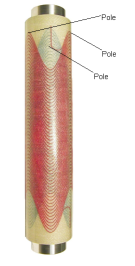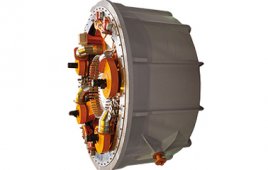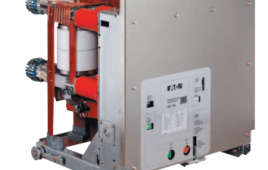The Double Helix design could be made by varying the pitch or wrap angle as needed. AML uses analysis software to predict field strength.
One way to wring cost out of a wind turbine is to eliminate the gearbox and at the same time, increase the power density of the generator which would allow reducing its size and weight. Advanced Magnet Lab, Palm Bay, Fla., says it has a generator design that may allow doing so. It uses the company’s 2002 physics discovery that produces transverse magnetic fields without harmonics or fields that are more uniform than those based on the modulation of solenoid windings.
The AML development called Double-Helix includes CNC manufacture methods that need no special tools or fixtures to provide precise placement of conductors on curved surfaces for single and multi-layer geometries.

The configuration shows how two layers of Double Helix produce a six-pole coil.
In the simplest Double-Helix design, a conductor is wound around a coil at about a 45° to perpendicular. A second layer would be wound at the opposite 45° so conductors cross about 90°. This gives a rotor or stator for a motor or generator with two poles. With a computer precisely controlling the location of the wire, and depending on the diameter of the core, which can be a cylinder, the two layers can cross at 90° many times giving a pure sinusodial field distribution of many poles. The accompanying image of red-wire coils shows a six-pole magnet which could work as either a rotor or stator. AML Chief Scientist Dr. Rainer Meinke invented the Double-Helix theory, software, and manufacturing.
At a recent conference, the company introduced its design for a10-MW and larger superconducting generator for wind turbines that would need no gearbox. In addition, it would weigh only about 65 tons versus the 500 tons needed for a conventional design with gearbox. AML President Mark Senti did say the company has a generator design with most components already proven, and is ready to build and demonstrate a subscale prototype by 2011.
The coils produce a magnetic field (vectors) that cancel along the cylinder axis but add in the radial direction.
Senti says the company “packages” its technology based on an integrated process of 3D coil design using the company’s CoilCAD software. “It allows finding a best magnet-based solution for application requirements instead of forcing conventional coil configurations, such as saddle or racetrack coils, to generate the required fields.” Pick here for an animation of a Double-Helix Coil.
The Double-Helix (DH) design leads to other possibilities. For instance, suggests Senti, take a copper cylinder and using a small diameter mill or a laser, cut in the cylinder along a path normally reserved for a conductor. For physical stability during machining, the thin copper cylinder is firmly mounted to a substrate. Now, says Senti, the cylinder becomes the coil and the cut paths (air gaps) insulators, or they can be filled with an insulator. The result is that the conductor cross sections (cylinder wall thickness by distance between cuts) can be a optimized to to significantly increase the magnetic field strength. “The current densities possible are two to five times what anyone has achieved, they approach superconducting power densities. The result is a stronger magnet that produces higher fields at reduced heat loads,” he adds.
For a Direct Double Helix, a CNC guided mill or laser cuts insulation paths in a cylinder of conducting material (aluminum here). Conductor cross sections can then be varied by altering distance between cuts to generate needed fields in certain locations.
The firm calls this variation Direct Double Helix (DDH) and says it works in resistive-conducting and superconducting applications. The magnetic fields are also more uniform with low harmonics, lower than those produced by other methods. In addition, rotors made with DDH in small-diameter motors could hit higher speeds than conventional design of a similar size because of they would be lighter.
Although the designs use conventional materials, more recent nanomaterials such a Graphene with its high thermal conductivity can be considered for magnetic applications because of the physical properties of Double-Helix and manufacturing techniques of DDH.
Additional applications include medical treatments and diagnoses in which DH and DDH allow greater precision for magnetic-field control while significantly reducing a system’s size and cost. For example, charged-particle-beam lines using protons (Proton Therapy) eliminate the need for radiation because a narrow proton beam can hit a tumor and miss most all normal tissue.

A field analysis and comparison for a four-pole magnet reveals significant differences between conventional racetrack and saddle coils verse AML’s Double Helix coils. The color variations indicate the magnetic flux density. The more uniform red around the DH coil indicates a uniform, almost perfect field without harmonics.
Filed Under: Generators




If one goes back to SOME of Nikola Tesla’s electric armature designs, you find very similar.
Mr. Dvorak,
I am a former aerospace student that has been thinking of something very similar for the last few years. I have a lot of 3d autocad experience and quite a few models and drawings. I would appreciate any sort of correspondence, if you are so interested.
Thank you,
Travis Spencer
Mr. Shoupe:
I read your comment, and you are welcome.
Your area sounds ripe for community wind development. Several companies spearhead these efforts. One is OwnEnergy at ownenergy.net and another is National Wind in Minneapolis.
They can provide guidance on how you might proceed to get a wind farm on what sounds like reclaimed land.
Good luck.
Paul Dvorak
Vietnam Veteran, 1968
The implications of this development will change the world in a fundamental way
Mr. Burns:
I would think so too. The engineer from the company I met at AWEA 2009 said that medical applications seem to be catching most interest so far.
We’ll both have to find their booth at AWEA 2010 in May and ask for an update.
Paul